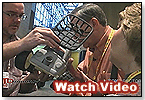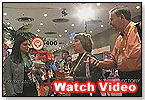
April 18, 2024

January 2011 | Vol. X - No. 1
How to Buy at a Trade Show
Six Tips to Come Home Selling
The following article was reprinted with permission from the author.
Information is power. Lew Platt, the former CEO of Hewlett-Packard, once famously said: “If HP knew what HP knows, we would be three times as profitable!” Information is all around us but the trick is, what to do with it.
If you are planning a trip to Toy Fair, your local merchandise mart or other trade show I have some advice for you:
1) Prepare – know your numbers. Not your macro numbers like how we did for the month but the micro numbers. What are your top five categories in gross sales and if you can access it, in terms of profitability. Some businesses use lots of loss-leaders which may sell a lot but actually cost them money. That’s not what you want. Look at all of your categories and find your top five to seven. Then find your bottom five to ten.
2) Analyze. Many independent business owners are chronic over-buyers. It’s so much fun to go to New York or Chicago and buy things! But if you bring something new in, that means something has to go. You can’t just keep putting more merch in your store. If sales were down 5% last year then your inventory level should be down 5% as well. (Watch videos of Fred and Karen Rosenberg, owners of On the Park, scoping out new vendors at Toy Fair 2008 in TDmonthly's upcoming documentary, Toy Frenzy!.)
things! But if you bring something new in, that means something has to go. You can’t just keep putting more merch in your store. If sales were down 5% last year then your inventory level should be down 5% as well. (Watch videos of Fred and Karen Rosenberg, owners of On the Park, scoping out new vendors at Toy Fair 2008 in TDmonthly's upcoming documentary, Toy Frenzy!.)
3) Make a shopping list. Go to the show looking only to add to your most profitable, best-selling categories.
4) Be liberal. With your best categories, go ahead, try new things, unproven things, things you have a hunch on. The marketplace looks to you for such items because those categories are paying off for you. You’re safe because, you’re “fishing where the fish are” trying new bait. Even if gosh forbid you buy a stinker, you will be able to move it out quicker because there is more demand in the category. With me?
 5) Be conservative. With your bottom categories, STOP. Don’t buy more because those categories aren’t contributing enough to your bottom line. I learned this in the coffee business. Everyone said, “tea is the next big thing, you need to expand your tea offerings.” We looked at tea sales which were less than 1%. Even if we doubled the menu, it still wouldn’t produce the jump needed to support more POP, product and training. Simply put, customers didn’t look to us for their tea needs. Instead we looked at the blended cold coffee drinks and tried various flavors because they represented 40% of sales – we were safe because people looked to us for those kinds of drinks and would be open to it. In your case, if you must replenish something, make sure it is a proven #1 best-seller or pass. Remember it was the pioneers who got the arrows; be a settler once an item has survived in the marketplace in your lower categories, then bring it in.
5) Be conservative. With your bottom categories, STOP. Don’t buy more because those categories aren’t contributing enough to your bottom line. I learned this in the coffee business. Everyone said, “tea is the next big thing, you need to expand your tea offerings.” We looked at tea sales which were less than 1%. Even if we doubled the menu, it still wouldn’t produce the jump needed to support more POP, product and training. Simply put, customers didn’t look to us for their tea needs. Instead we looked at the blended cold coffee drinks and tried various flavors because they represented 40% of sales – we were safe because people looked to us for those kinds of drinks and would be open to it. In your case, if you must replenish something, make sure it is a proven #1 best-seller or pass. Remember it was the pioneers who got the arrows; be a settler once an item has survived in the marketplace in your lower categories, then bring it in.
6) Use an open-to-buy. In its most basic form it means you can’t buy unless something else has sold. This helps keep you from overbuying for your store.
These are by no means all the tips to successful merchandise selection but they should help put money in your jeans, instead of in your vendors. That’s because merchandise is like milk; it goes bad quickly so you only want to carry what you need, not what you want.
I cover more on this in my new book, "The Retail Doctor's Guide to Growing Your Business."
Copyright © 2024 TDmonthly®, a division of TOYDIRECTORY.com®,
Inc.



 things! But if you bring something new in, that means something has to go. You can’t just keep putting more merch in your store. If sales were down 5% last year then your inventory level should be down 5% as well. (Watch videos of Fred and Karen Rosenberg, owners of On the Park, scoping out new vendors at Toy Fair 2008 in TDmonthly's upcoming documentary, Toy Frenzy!.)
things! But if you bring something new in, that means something has to go. You can’t just keep putting more merch in your store. If sales were down 5% last year then your inventory level should be down 5% as well. (Watch videos of Fred and Karen Rosenberg, owners of On the Park, scoping out new vendors at Toy Fair 2008 in TDmonthly's upcoming documentary, Toy Frenzy!.) 5) Be conservative. With your bottom categories, STOP. Don’t buy more because those categories aren’t contributing enough to your bottom line. I learned this in the coffee business. Everyone said, “tea is the next big thing, you need to expand your tea offerings.” We looked at tea sales which were less than 1%. Even if we doubled the menu, it still wouldn’t produce the jump needed to support more POP, product and training. Simply put, customers didn’t look to us for their tea needs. Instead we looked at the blended cold coffee drinks and tried various flavors because they represented 40% of sales – we were safe because people looked to us for those kinds of drinks and would be open to it. In your case, if you must replenish something, make sure it is a proven #1 best-seller or pass. Remember it was the pioneers who got the arrows; be a settler once an item has survived in the marketplace in your lower categories, then bring it in.
5) Be conservative. With your bottom categories, STOP. Don’t buy more because those categories aren’t contributing enough to your bottom line. I learned this in the coffee business. Everyone said, “tea is the next big thing, you need to expand your tea offerings.” We looked at tea sales which were less than 1%. Even if we doubled the menu, it still wouldn’t produce the jump needed to support more POP, product and training. Simply put, customers didn’t look to us for their tea needs. Instead we looked at the blended cold coffee drinks and tried various flavors because they represented 40% of sales – we were safe because people looked to us for those kinds of drinks and would be open to it. In your case, if you must replenish something, make sure it is a proven #1 best-seller or pass. Remember it was the pioneers who got the arrows; be a settler once an item has survived in the marketplace in your lower categories, then bring it in.